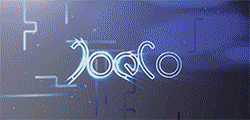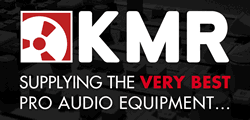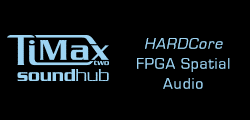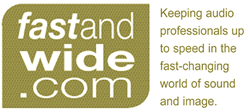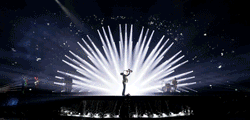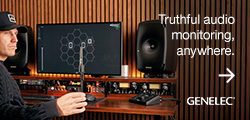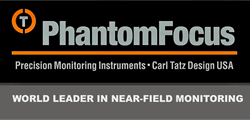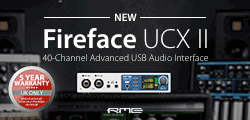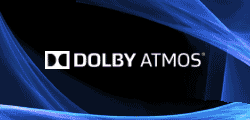![]() Following the coronation of King Charles III in Westminster Abbey the start-studded Coronation Concert took place at Windsor Castle, with Terry Tew Sound & Light appointed as the official audio supplier. Among the key kit selections were DiGiCo Quantum 7 consoles and Shure’s Axient Digital wireless mic system.
Following the coronation of King Charles III in Westminster Abbey the start-studded Coronation Concert took place at Windsor Castle, with Terry Tew Sound & Light appointed as the official audio supplier. Among the key kit selections were DiGiCo Quantum 7 consoles and Shure’s Axient Digital wireless mic system.
Alongside the 20,000 attending the concert, it was simultaneously broadcast to millions of viewers in more than 100 countries.
Artists appearing included Lionel Richie, Katy Perry, Andrea Bocelli and Take That, accompanied by performances from the Royal Opera, the Royal College of Music, and the Royal Ballet. Sound designer for the event was Ben Milton, working with the event organisers and audio engineers to design a bulletproof sound system.
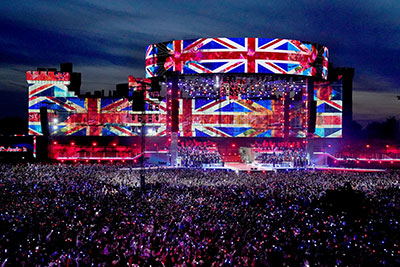 Having been part of the audio team for the Queen’s Platinum Jubilee in 2022, Milton was delighted to once again be part of such an historical occasion. ‘We were fortunate to have the same tried and trusted creative team for this event,’ he says. ‘The continuity was invaluable and gave us a well-established methodology for this complex production.
Having been part of the audio team for the Queen’s Platinum Jubilee in 2022, Milton was delighted to once again be part of such an historical occasion. ‘We were fortunate to have the same tried and trusted creative team for this event,’ he says. ‘The continuity was invaluable and gave us a well-established methodology for this complex production.
‘Under the direction of Julia Knowles and with Mark Sidaway as the Executive Producer for the BBC, Nigel Catmur as lighting designer and set design by Stufish, I had the privilege of reprising my role. Returning for a second time was an incredible experience, one that I owe to the close collaboration with Kev Duff and Andy Deacon from Zen Broadcast. The three of us approached the project with a cohesive audio strategy, creating a harmonious blend for the entire show. With the concert being both live and televised, our aim was to make it sound good for television viewers, as well as sounding magnificent at the venue.’
The circular stage featured two motifs with elements forming the Union Flag, and a halo-like screen suspended on four pillars, enveloping the roof and representing the crown.
‘I had a lengthy collaboration with the immensely talented Zarya Vrabcheva from Stufish, and Nigel [Catmur] LD to shape the stage design, striving to make it beautiful,’ Milto continues. ‘The backdrop of Windsor Castle made it all the more important to make it look and sound as special as we could.’
He worked with Vrabcheva to conceal the main PA, hiding the system within the pillars, which were clad with mirrors, making it virtually invisible. This attention to detail created a masterful illusion, ensuring audio quality while preserving the stage’s visual integrity.
‘The final stage design guaranteed that the audience would hear everything they needed without any difficulty in discerning the performers and presenters speaking from its farther reaches. It aimed to minimise sound spillage and colouration, ensuring the audience experienced synchronised audio across all aspects,’ he explains.
The high I/O count required ensured that the consoles were DiGiCo Quantum 7s. Milton recounts that Take That’s rendition of ‘Never Forget’ was performed alongside the choristers of St George’s Chapel and hundreds of other singers and dancers, giving the show an uplifting finalé.
‘At that point, we had 400 performers on stage including Take That, the choir, military drummers and all further singers and dancers on the parapets – it was the absolute maximum we could have,’ he says. ‘To achieve that level of complexity was undoubtedly a technological feat, expertly managed with the Quantum 7 consoles,’ Milton adds.
‘Being asked to supply all aspects of audio and RF was going to bring some unique challenges and opportunities,’ says Terry Tew. ‘Having worked closely with Zen Broadcast and Ben Milton for many years gave all parties the confidence that we were in each other’s capable hands. The consoles and racks were connected via 4.7km of Neutrik Opticalcon fibre. The Quantum 7s were invaluable and a genuine necessity, ensuring we could cater for the ever-evolving spectacle that we wanted to deliver.’
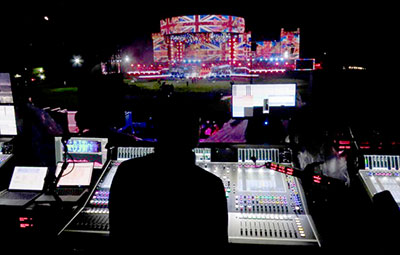 Two Quantum 7s and five SD-Racks on an optical loop were dedicated to monitoring – one Quantum 7, manned by Toby Chester, handled the two 40-piece choirs, orchestra and the house band, while sending submixed orchestral stems to Seamus Fenton on the second Quantum 7, which was dedicated to the artists. A third Quantum 7 was available as a backup.
Two Quantum 7s and five SD-Racks on an optical loop were dedicated to monitoring – one Quantum 7, manned by Toby Chester, handled the two 40-piece choirs, orchestra and the house band, while sending submixed orchestral stems to Seamus Fenton on the second Quantum 7, which was dedicated to the artists. A third Quantum 7 was available as a backup.
‘The orchestra was on one ring of Aviom mixers, the band were on another ring and the choirs were on IEM mixes,’ explains Fenton. ‘I took the band and several submixes of the orchestra and choirs from Toby – 300-plus channels – and I gave him all the artist vocals, backing vocals and the Steinway. I submixed the Steinway down to one stereo stem with reverb and had 15 in-ear monitor mixes, spread across the artists, as well as several mixes of floor monitors positioned all over the stage and up on the castle garden ramparts.’
With tight changeovers between artists and little time to do line checks, Fenton made use of the Quantum 7’s Snapshot feature. ‘I always try to have a reverb per artist for the entire show, but this show was too big to achieve that, so I had to Snapshot. I had a Snapshot for everything to allow me to share reverbs and make sure I could send Toby the right vocals so he could distribute them across all the musicians. It required a lot of housekeeping, so we set up a talkback bus on the consoles so Toby and I could talk to each other in our ears, and make sure that what we were doing was aligned.’
The console’s All Pass Filter was also an essential tool: ‘I got a presenter mix from Chris at FOH, which is quite normal on televised shows. With the All Pass Filter engaged on the presenter mix from Chris there could safely be “one fader to rule them all”, so when a presenter came on stage, that channel came up everywhere as the presenter channel was routed to the matrix that was going to the on stage speakers. That allowed Chris to simply fade things up into the PA and on the stage, irrespective of what I was doing. Things like that are really handy.’
FOH was a similar set-up. Here, three Quantum 7s, with FOH Orchestra Engineer Stefano Serpagli handling the orchestra and the choir on one. This was then submixed into the second Quantum 7, managed by Davide Lombardi, for the house band, direct instruments, and solo vocalists.
The third Quantum 7 looked after the presentation components and VTs, and was manned by Chris Vass, who was the final port of call. ‘Effectively, Chris was the end mixer for the show, and had a stereo mix plus everything else,’ Milton says.
The broadcast element benefitted from the same attention to detail, with Sound Supervisors Kevin Duff, Andy Deacon (of Zen Broadcast Ltd) and Howard Nock mixing in three OB trucks. Zen OB3 featured a further Quantum 7B forwarding an orchestra, house band and choir mix to Kevin Duff in Zen OB1.
‘Kev mixed all music components, which were passed on to Sound Supervisor and Engineer Howard Nock in one of the two Timeline OB facilities. Howie mixed live-to-air, ensuring the audio had a consistent flow through all areas of the show,’ says Milton.
‘It was quite a traditional process, but the numbering of performers and the workflow between consoles needed careful planning. We couldn’t have done it without the Quantum 7s, and even they were maxed out,’ he says. ‘Mustard processing provided enhanced flexibility and options for precise control and creative adjustments within the mix, and the engineering team relied heavily on features like the All Pass Filter on the Mustard EQ, along with the general EQ and compression capabilities of the Quantum engine, as well as Nodal processing at monitors.’
On the mics
The show’s miking set-up involved 24 channels of Shure’s Axient Digital Wireless System handhelds and body packs, and 255 Shure Sound Isolating Earphones. The technical team used a Shure AD600 Axient Digital Spectrum Manager, along with Shure Wireless Workbench (WWB) software, to monitor the RF spectrum on-site. Additionally, six hard-wired PSM900 In-Ear Personal Monitoring Systems were used on-stage.
‘The scope of the Windsor Concert included 100 handheld microphones, 3.7km of RF cable, 139 radio mic channels, 58 IEM channels, 255 in-ears, 39 body packs, 243 IEM packs and more than 1,000 rechargeable batteries, showing that sustainability is possible even at this scale,’ says TTSL Head of RF, Jonathan Edwards. ‘From a software perspective, we relied on WWB to create the frequency plot for the event and used the software’s zone mode across the different studios from where the concerts and ceremony were monitored. This gave us the optics and all RF details in real time, which was key for the success of these memorable events.’
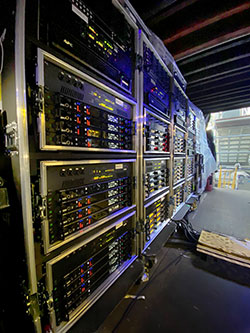 A mixture of Shure SE 215s and SE 425s Sound Isolating Earphones were distributed to artists, musicians and choir members. Various Shure capsules were used too, including Beta 87, KSM8 and KSM9, the SM58 and Beta 58s – all of which ensured high-quality audio throughout the show.
A mixture of Shure SE 215s and SE 425s Sound Isolating Earphones were distributed to artists, musicians and choir members. Various Shure capsules were used too, including Beta 87, KSM8 and KSM9, the SM58 and Beta 58s – all of which ensured high-quality audio throughout the show.
‘From an IEM perspective, we felt Shure could give us the confidence that the artists would be happy with PSM1000, in fact many of them specified it on their riders,’ Edwards says. ‘When it comes to wireless, Shure Axient Digital System is our go-to performance kit, whether it be for TV programmes, events or the Coronation Concert.’
When specifying the kit, the team needed to be aware of artist riders and the spectrum limitations. ‘A big benefit was that Axient Digital is capable of using DME spectrum, so all of the radio mics were in the frequency range needed. Due to the high RF channel count we used every portion of DME spectrum available on-site.
‘We are very proud of the overall outcome and our achievement, our biggest show to date,’ Edwards continues. ‘All the equipment worked seamlessly; two months of planning, three weeks of warehouse prep, the off-site rehearsals and a week on-site, contributed to the spectacle that night. I’d like to give a personal thanks to all teams at TTSL, along with a special mention to Ben Milton, Andy Deacon and Kev Duff.’
‘Shure’s relationship with Jonathan and the rest of the team at Terry Tew Sound & Light is built on trust, loyalty, and a shared passion for excellence,’ says Shure UK Director of Pro Audio Sales, Stuart Moots. ‘Their support and feedback inspire us to continuously improve our products and we greatly value their choice to use Shure. It’s been fantastic to see both wired and wireless Shure systems deployed on such a prestigious event and to know it performed flawlessly in front of a global audience is testament to Terry, Jonathan and their entire team. We are all very proud at Shure to be involved in such an historic event.’
‘We’re immensely proud to be a part of this historic event and thankful to Zen Broadcast and Ben for their expertise, support and trust in us to deliver,’ says Tew, adding ‘a special mention to our dedicated and hard-working team back at base who worked tirelessly for the weeks prior to the event.’
‘Right from the outset, Dave [Bigg, Production Specialist at DiGiCo] lent his technical expertise and keen eye to everything,’ Milton adds. ‘I know my summer has started when Dave is next to me, and he and Mark [Saunders] are just lovely people to hang out with. DiGiCo consoles once again demonstrated their exceptional value and unwavering reliability, reaffirming the company’s world-class reputation.’





